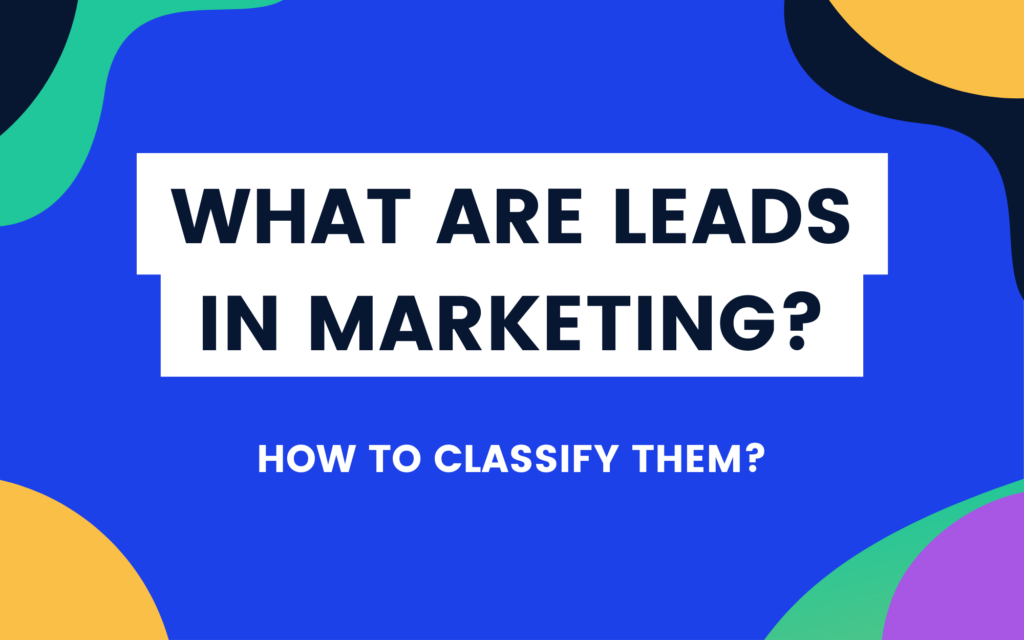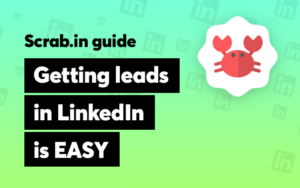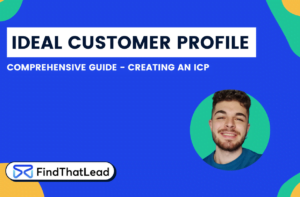What are leads in marketing
Winning new customers is one of the biggest challenges companies face on a daily basis. The entire strategy, from marketing to price marking, is geared towards generating leads capable of transforming into customers.
It requires companies to understand the behavior of their target audience and the market in which they are inserted to create Digital Marketing actions focused on attracting leads. But, what are leads in marketing?
For the whole process to work, it is necessary that the concept of lead is clear to those responsible for the creation and execution of the strategy. From FindThatLead & Scrab.in we are going to explain everything you need to know.
What is the meaning of leads in marketing?
If you don’t know what are leads in marketing, you have to understand that a lead is a way we call a person who, apparently interested in the product we offer, has provided us with a minimum amount of information to be able to contact them.
For example, their first name and telephone number or e-mail address. They have given us just enough to know their name (and therefore their gender), and one (often only one) way of contacting them, and initiating a purchase process (or sale, depending on how you look at it).
The Lead is, therefore, a still cold contact that is still in the initial phase of the process, starting to evaluate alternatives, between the high and medium-high phase of a “conversion funnel”.
Leads are not only obtained through digital marketing. Even before the invention of the internet, there were already actions to “generate leads” in the non-digital world.
For example, when in a supermarket, in exchange for participating in a travel competition (for which we only had to fill in a small piece of paper with our name and telephone number) we were offered a gift or a discount on a certain product. After a few days, we received a call from a bank, a telephone company, or a travel agency.
Despite the advent of digital marketing, these practices continue to occur.
What should I do to generate leads?
Now that you understand what are leads in marketing, it’s time you know how to get a lead. There are many lead generation strategies and We can get a lead through different ways, through our Social Networks, the creation of landing pages, a blog or our own website.
1. The website itself
Just because someone visits our website does not make him or her a lead. We need that person to want to communicate with us or, at least, to allow us to communicate with him or her in a personalized manner. For this, our website must be well oriented from the home page with calls to action.
Why would someone want to leave us their details if they have not yet bought anything?
This is the key question for lead generation. To achieve this, it is necessary that the fact of registering means a contribution of value for the user:
Economic value: Registering can mean receiving a discount code or access to special offers only for registered users.
Intangible value: Registered users can access restricted areas of the website or, more commonly, receive a newsletter by email. In this case it is the provision of useful or interesting content for the user that generates value.
Ideally, both should be combined. A newsletter should not only be promotional, nor should it be limited to providing interesting content. It should have both. A very useful element for lead generation is the creation of landing pages.
These “landing pages” are alternative gateways to your website and allow you to target a specific audience segment that may be interested in a specific product or service.
Landing pages serve, therefore, to “fish” in Google’s universe for those potential buyers who carry out searches related to that specific product. And, like the rest of our website, they must be prepared to facilitate the conversion of visitors into leads.
2. Social media
Lead generation is, or should be, one of the main objectives of any company or brand that is present on social networks (at this point in the film, almost all of them). Therefore, our content strategy on social networks must be very well oriented to achieve this goal.
These tips can provide valuable insight on how to effectively promote your brand and convert followers into leads.
A follower on social networks is not a lead. It is not enough that they follow us, the important thing is that through social networks we manage to interest enough of our followers so that they ‘take the lead’ and decide to interact with us in those contents that are directly related to our products or services.
3. Advertising
The best thing about online advertising is that it breaks the barrier of one-way communication. An advertisement on the Internet can be the way for a user who is exposed to our advertising to become a lead. That is why it is important to design this advertising so that it is eye-catching for the segment we are interested in. If we are interested in capturing a lead, we have to include calls to action.
We can even convert an advert into a form in certain cases. A classic scheme, but quite effective, is the one that interposes a landing page, which is the one we actually advertise. This landing page is designed for the sole purpose of capturing leads.
What leads are for?
As we said, when we have talked about what are leads in marketing, nowadays, lead capture is an important factor in a company because this process helps us to segment and personalize better the type of target that accesses our brand. The more information we get, the easier it is to personalize content and attract the audience.
In addition, leads provide content and conversion in order to maintain a two-way relationship between company and customer. It is an opportunity for loyalty.
What are leads in digital marketing?
Nowadays most leads are obtained through digital marketing actions: people who arrive at the landing page of a website and, in order to download an ebook, or simply request information about a product, give us their minimum contact details.
It has been proven that if we offer an incentive to the visitor (the possibility of downloading a whole or part of a book, a discount…) they are more likely to give us their minimum contact details.
So, what is leads in digital marketing? Leads are people who give us minimum data because they are still in the early stages of contact. They are still in the cold stages, far from making a purchase decision, and do not want to give us too much personal data.
And in fact, it has been shown that, in these early stages of contact, it is a mistake to try to obtain more data: in the form of a landing page, when the customer is not yet in the final stages of the purchase process, it has been proven that the more data is requested in the forms, the fewer people leave us their data.
The number of fields in a form is inversely proportional to the number of people who fill it in and send it.
What types of leads exist?
Now that we know what a lead is and how we can get them, we are going to analyze in the following section what types of leads we can find. This section is very interesting because when we get a lead in our business we are taking a big step, we go from having a user to a user with interest. For this reason, it is necessary to follow up so that they reach the final stage of our funnel.
In Inbound Marketing, not all leads are worth the same. Some leads have been obtained without the user knowing what our company offers, while others consider our content and the services or products we offer to be interesting. For this reason, it is so important to differentiate them, as not all of them have the option of becoming sales.
There are two categories in which to classify the types of leads according to their criteria, by temperature and by level of qualification.
Leads by temperature
Cold leads
These leads belong to those users who may show some interest in our content or in some of our services or products. But, as a general rule, they do not have many possibilities of becoming customers. This lead will remain at the beginning of our conversion funnel. The most common is to get them through email marketing campaigns or from free content.
Tempered leads
These leads show greater interest than the previous ones, which is why they tend to visit our site relatively frequently and follow our publications with relative assiduity. This type of lead is not ready to buy but is ready to learn about our products or services.
Hot leads
These are those leads that are ready to buy. They usually contact our company to ask for more detailed information about a product or service or about some aspect of our site that has aroused their interest. These are usually classified among the quality leads, as their interest has been progressive and they are already at the end of our conversion funnel.
![What Are Leads In Marketing? [Types Of Leads And How To Classify Them] 1 what are leads in marketing](https://blog.findthatlead.com/wp-content/uploads/2022/03/thermometer-gcd37f1dc8_1280-150x300.png)
Leads by qualification
Subscribers
Almost a lead, although they are not yet in the initial phase of the conversion process, they have agreed to receive information. It could be through the newsletter form, the subscription to the blog or to get an e-book, therefore, we will have their email.
The next step would be to convert them into leads, since having established the first contact, it will be much easier to convert them compared to other users of whom we do not have any information.
To achieve this, we should offer them quality content, free courses, or other material that may be of interest to them so that they can provide us with their details. These are the ones belonging to the TOFU or Top of the Funnel phase.
Qualified Leads
These are users who have repeatedly shown interest in what we offer. For example, they have asked for our services on several occasions.
In these cases, it is very positive to ask these users for more information. Try to deepen the relationship we have with them. One option is to expand or vary the forms to meet this objective. In this case, the qualified lead will be in the MOFU or Middle or the Funnel phase.
Sales-qualified Leads
These are users who are ready to buy our product or contract our services. These leads tend to advance in our marketing funnel and therefore respond to an offer that is closer to the product or service we offer. For example, a request for a demo, a trial, a sample, a telephone meeting, etc.
The information we collect from this user must be considerably more extensive in order to be able to close the transaction later on. The qualified lead for the sale will be in the BOFU phase or button of the Funnel.
Phases our leads go through
In order to know in depth the leads that come to our website, we will use analytics. For this, there are multiple tools that will provide us with valuable information about the traffic and conversions obtained.
In this way, we will be able to know the behavior of our users and where they come from. From this, we can define the conversion funnels to clearly see how many leads we get from our web traffic.
TOFU or Top of the Funnel
The first phase of our lead. This is the moment in which our user shows some interest, but is not yet ready to buy, is not a customer. In this phase, the information and usability of our website is very important.
Our users must navigate through our site easily and find the information they are looking for without complications. If we do not fulfill these two premises, they will never move on to the following stages and we will not achieve our objective.
MOFU or Middle of the Funnel
The second stage of our lead. It is the intermediate point, in which our users already know our products and services, so they are clear about their needs and interests. This is the moment when they go from being simple users to qualified leads.
Information request phase. From this moment on, we have to be very clear about what the proposal is going to be in order to obtain the next step, the purchase.
BOFU or Bottom of the Funnel
The third phase is the definitive one. This is the moment before the sale, the one that will determine the closing of the sale. Only qualified leads will come into play. They have your company as one of those that can satisfy their needs, so this is the most delicate moment.
These are leads that are on the verge of becoming customers but are not yet customers. At this point, we must encourage contact and offer valuable content to get them to make a purchase decision.
Lead nurturing
Lead nurturing is the process of preparing and accompanying marketing leads through the conversion funnel, offering them the right incentives for the stage they are in (from generic information to offers and discounts).
To carry out a good lead nurturing strategy, we can follow these four steps:
- Decide on the segment we are going to work on (which we have already classified previously thanks to lead scoring).
- Establish the objectives (step to the next phase or final conversion).
- Define the communication sequence.
- Measure the results and adjust.
What are leads in sales?
A sales lead is a potential customer who gives his or her data to a company. In other words, a person whose data (such as name, telephone number and email address) we have because they have voluntarily given them in exchange for something.
Obviously, he or she is interested in what the company offers and is open to commercial communications. After a call or an email, they can become a customer. It is a sales opportunity that is part of inbound marketing.
Why are leads so important?
You need to capture leads because they are the basis of any Digital Marketing strategy, they will also be your potential customers and those who will recommend you to others.
Accompanying them from the moment they discover your business until they make a purchase is important, so focus on researching:
- Where these leads might be
- From which channels you can attract them
- What information they are looking for
- What content do they find interesting
- How do you keep in touch with them
And rather than focusing on quantity, you should look at quality. There are leads who just want to browse your content but are not looking to make a purchase. So create strategies to segment and stay with those who are interested in your product or service.
Get to know your customers better through your leads
Knowing your leads helps you to have a better relationship with your current customers. If you review the information of each one of them, you can see which needs are repeated. Then you can send them personalized offers and messages.
Your customer service, marketing and sales teams should support each other. Marketing and customer service gather key information from leads or customers who have questions or problems, and sales, with support from customer service, offers the best solutions.
Following up with existing customers and leads is an effective way of showing interest in the consumer and generates a positive image of the company. It allows you to detect when they are dissatisfied with the service and when they are ready to move forward in the buying process.
But remember, not all your leads and customers are of equal value to your company. By segmenting them and identifying the most suitable prospects (who are willing to spend more, who are repeat buyers, etc.) it will be easier to personalize your ads, offers and messages.
Identifying the most satisfied customers is also useful. You can ask them for references or accounts of their shopping experience. Use that information to create reports, and success stories and highlight good reviews on your social profiles or website.
Why are leads key to inbound marketing?
As part of the inbound marketing methodology, leads are a fundamental part of the different strategies that make up this methodology.
Depending on the nature of the lead and its stage in the sales cycle, a company can design different strategies to qualify it and lead it organically towards the purchase or acquisition of the product or service.
Since there are different stages in the inbound marketing process, it is of utmost importance to know and properly develop your buyer persona in depth and confirm that your product or service is really what your prospects need.
The buyer persona will provide you with valuable information to classify your leads and allow you to know how much interest they have in your brand and what level of engagement they have with it.
The nature and type of leads additionally allow for more specific campaigns that are targeted to the right people. Leads are key in this process because they allow you to classify the different people who have shown interest in your brand, which makes it easier to identify those who are most likely to continue with the buying cycle and close it.
This way you can combine the efforts of the different teams in your company and achieve a higher number of sales.
What to do after receiving a lead?
Now, once you have a lead, you must be clear about your ultimate goal and the process you want to put in place to convince them to buy your product or service. You have to keep their interest throughout this process and convert them into customers first. Put these two techniques into practice to convert your leads into customers.
Lead Nurturing
Consists of taking a lead by hand and taking them through the whole process of buying your product. This is done by sending a series of personalized automatic emails. The idea is that you offer your potential customer a series of valuable content to convince them that they need you.
Lead Scoring
Is a technique that is based on attributing a number to your leads according to a series of actions and characteristics in reference to how much or how little they are close to your buyer persona. The higher the number, the closer they are to your buyer persona and the more they interact with your website.
Now it’s time to put it into practice: Let’s get clients! Why don’t you start by sending an email to those potential clients that you have yet to contact by applying all the rules learned? START IT HERE!
Discover how to increase your leads with media content.





 BONUS:
BONUS: The Challenge: Join this free course and I guarantee that after 5 days you will have the necessary skills to start generating B2B clients Growth Hacking and Prospecting techniques.
The Challenge: Join this free course and I guarantee that after 5 days you will have the necessary skills to start generating B2B clients Growth Hacking and Prospecting techniques.